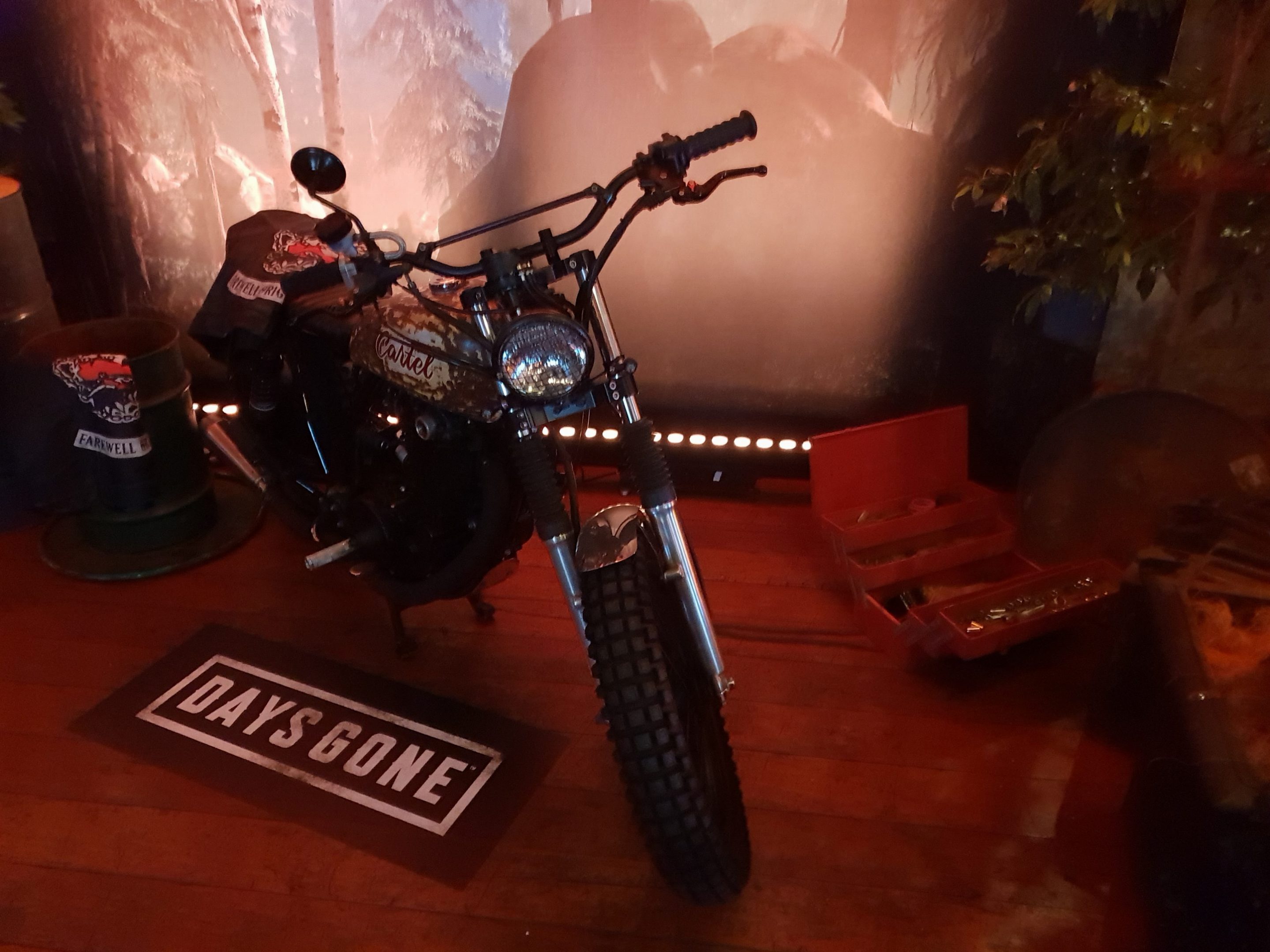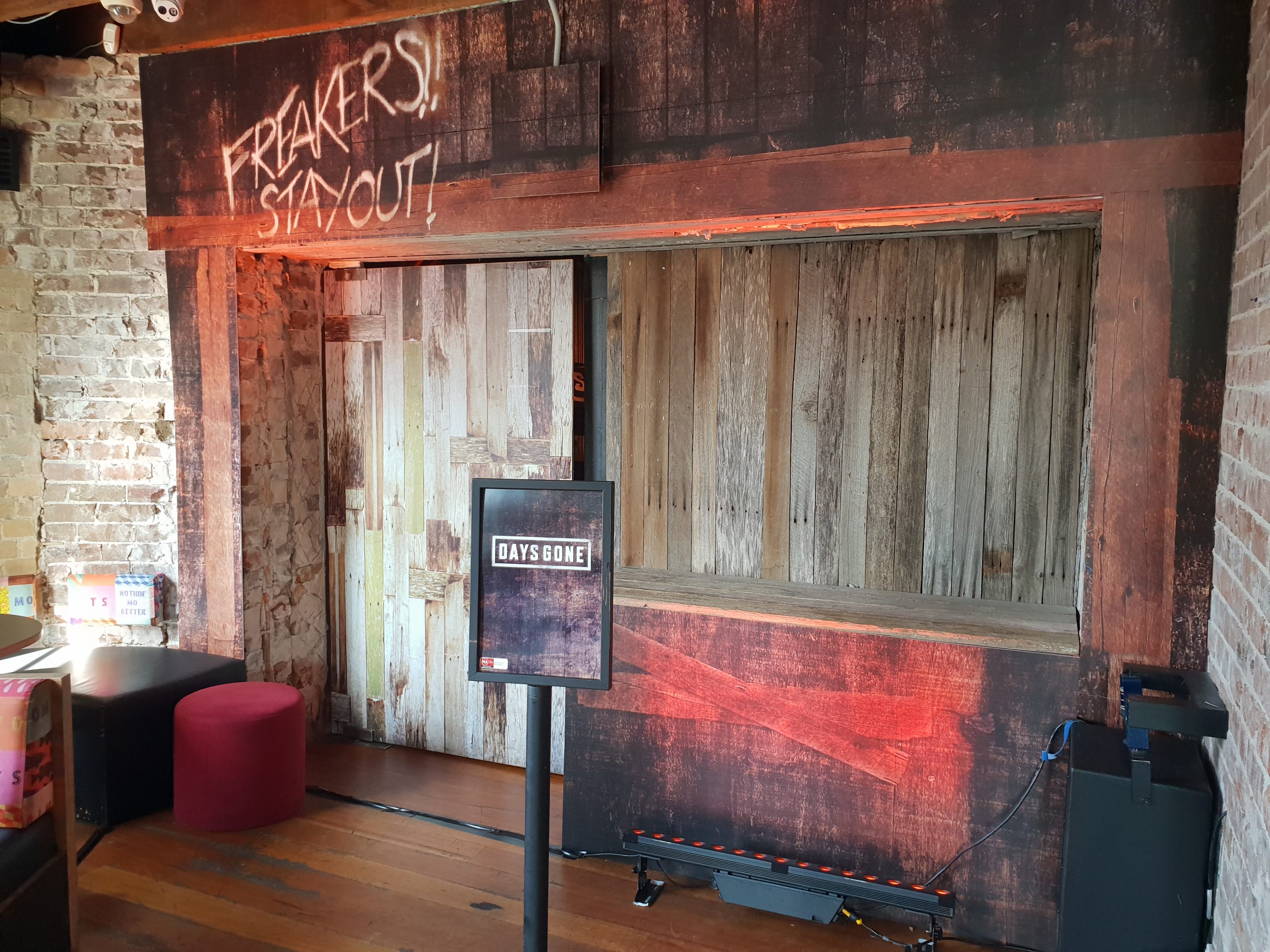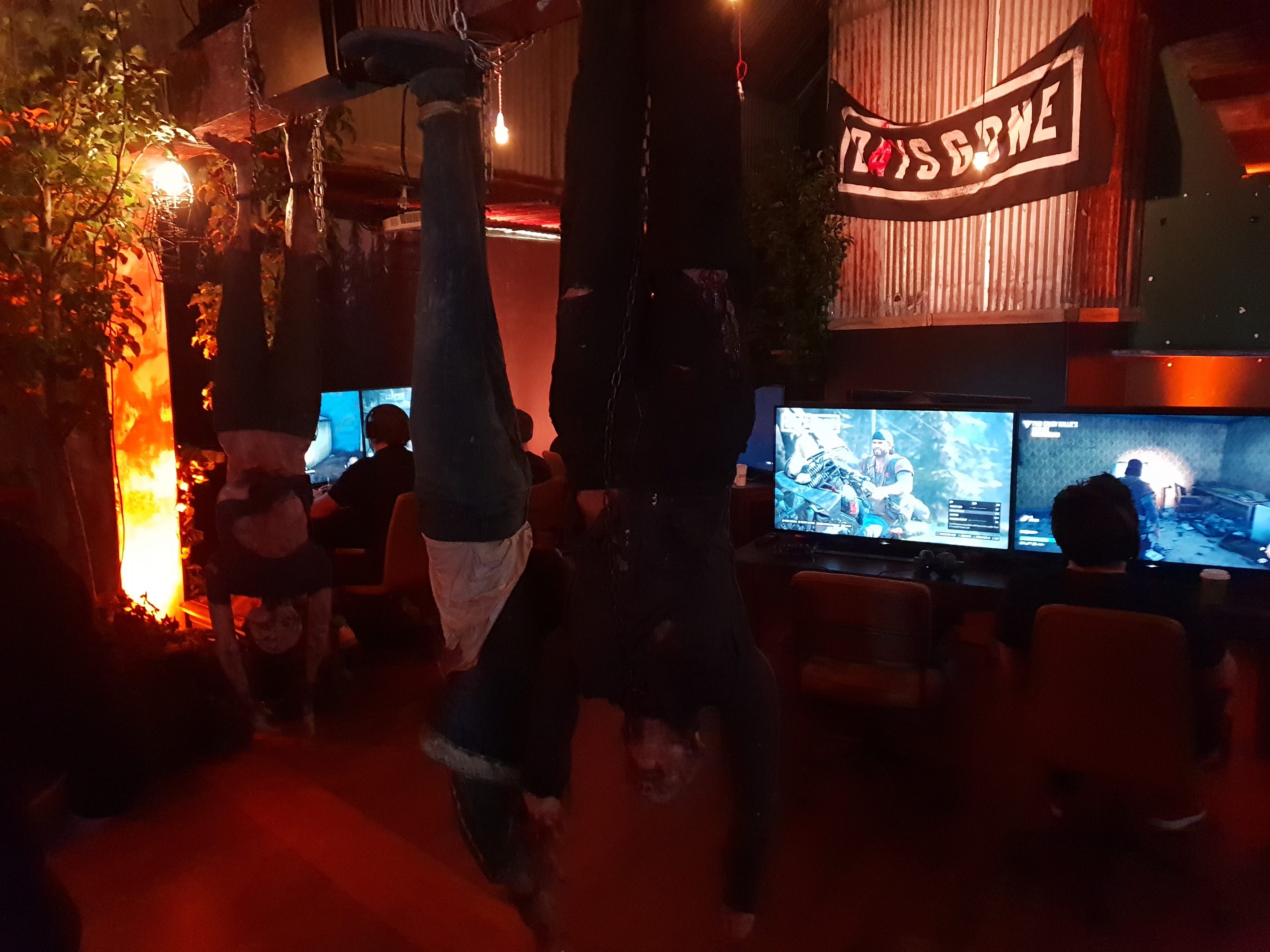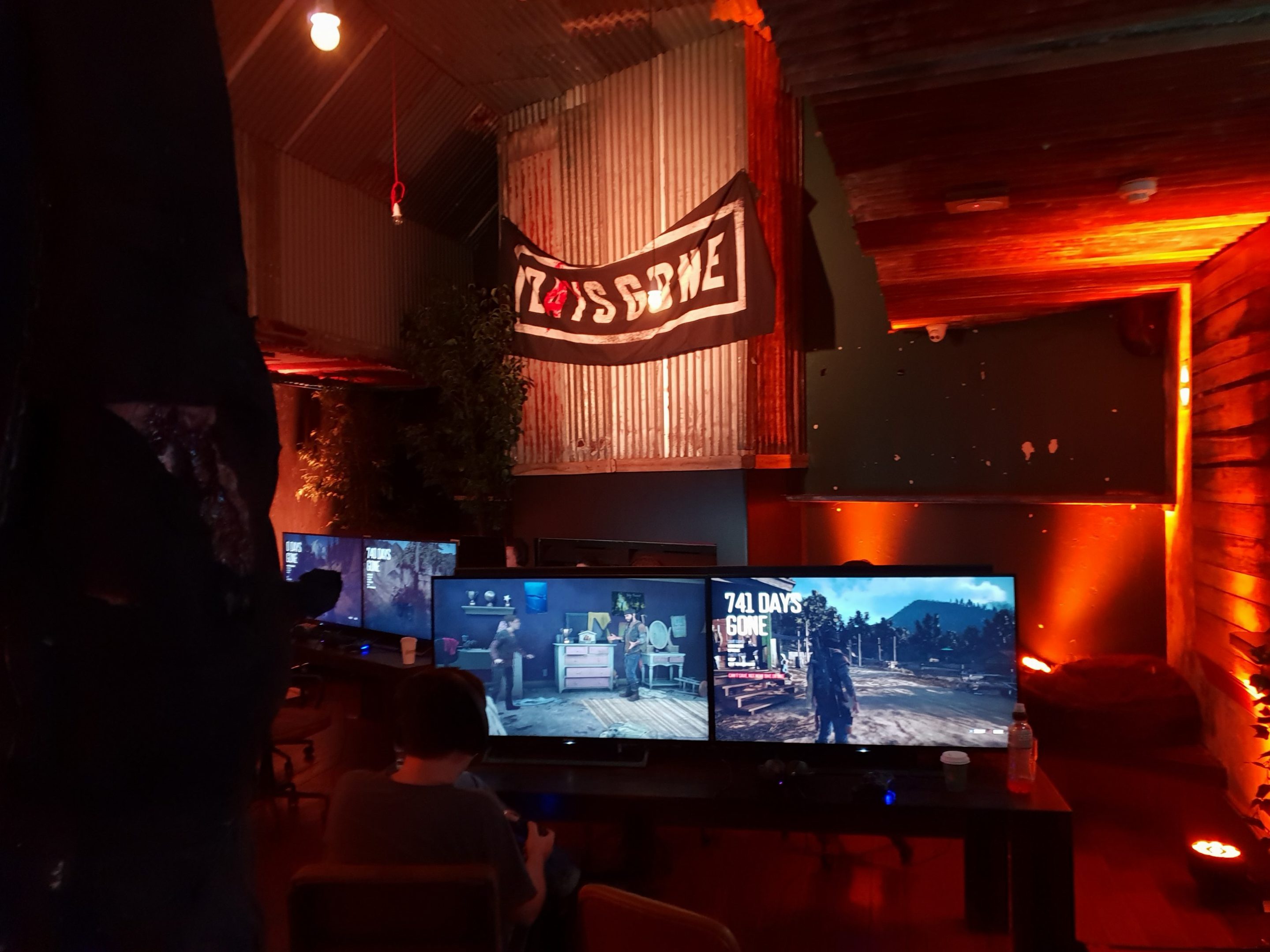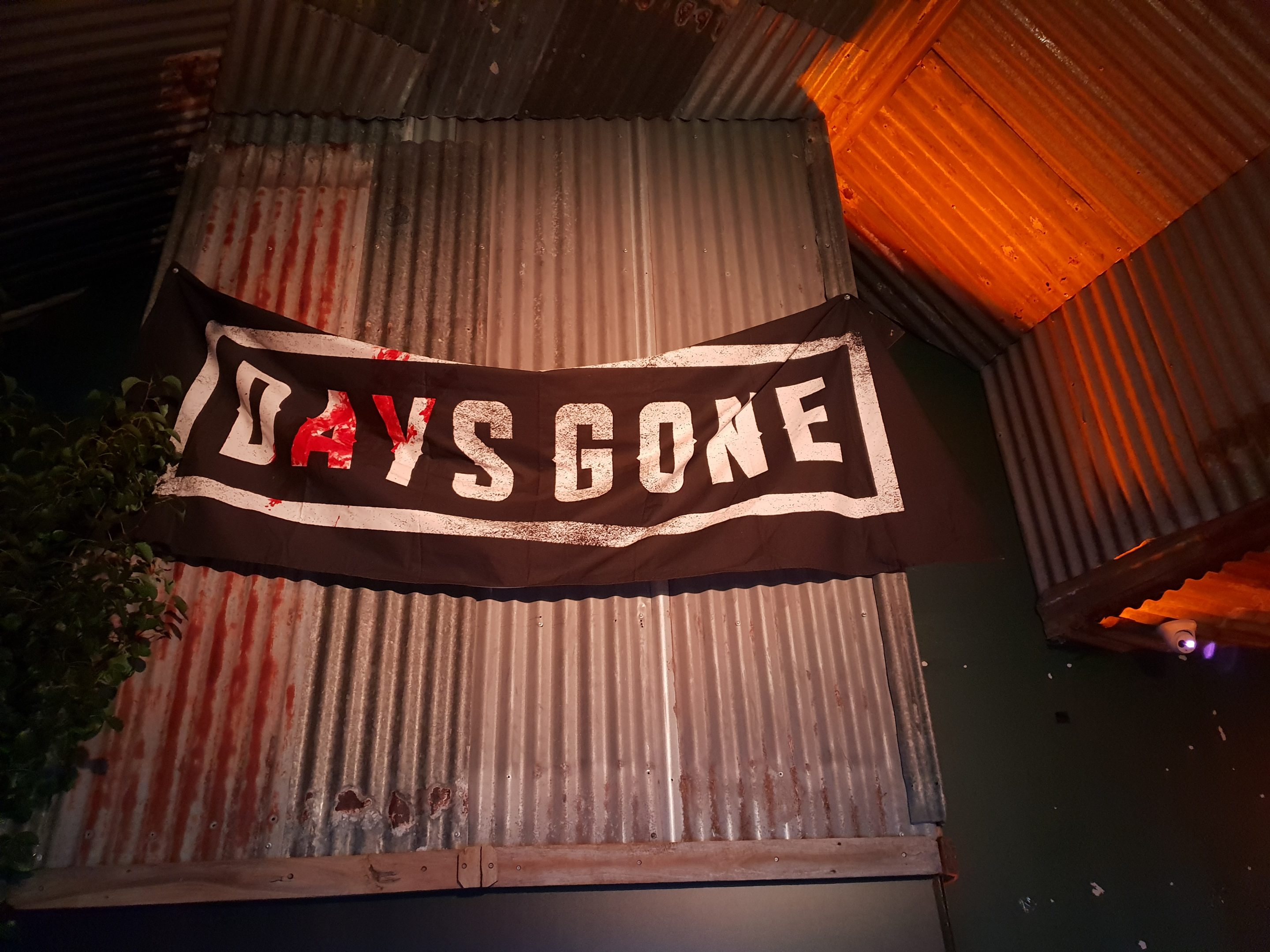In the corner of a pub in Newtown, Sydney was a corrugated iron barricade. The words “Freakers! Stay Out!” scrawled above the door in white spray paint.
Inside and down a set of stairs was a room covered wall to wall in corrugated barricades, wooden beams and spotlights, as well as makeshift glowing oil drums. In one corner, a stripped out bike with “Cartel” scrawled across it, it looks like it was once an old Honda CB450.
In the middle of the room, hanging lifeless by their ankles are three zombies, their hands dropping limply to the floor and their clothes bloody.
High-up on the far wall is a makeshift banner; Days Gone.
We were invited by Sony to sit down and play through the first two or so hours of the game, as well as a snippet about six hours in. We also sat down with Emmanuel Roth, Senior Animator and 14-year veteran of Bend Studios to talk about the game.
Days Gone Preview
Between the roar of motorbike engines, the distant screams of hordes of the undead, and the resounding crack of a rifle here’s what I thought.
First up, it bears mentioning that Days Gone has a fight on its hands. It’s not just one of many open world games, or one of many zombie games in the last few years, but somewhere between. Unfortunately, that means it’ll be butting heads with games like The Last of Us, Dead Rising and State of Decay. All of which have established fanbases that are there for the story, the weirdness or the strategy besides.
That being said, everything I saw of Days Gone feels capable and confident it what it’s doing, even if what it’s doing feels a bit derivative.
On the road
The demo began with protagonist Deacon St John — yes, the name sounds like a wrestler or a porn star — and his buddy Boozer chasing down a fellow bikie who they clearly have a bone to pick with. You chase him through mountain trails and across roads, dodging bullets and trees as you go.
This was the first experience of the motorbike handling in Days Gone and I must say I’m pretty happy with how it feels. As an avid biker myself (leather jacket and all), motorbike controls are always a bit of a sticking point for me.
Grand Theft Auto V had decent bike physics, while Just Cause 4 had me swearing off bikes for good after five minutes.
This might take some imagination, but the trap a lot of games fall into is giving you direct control over the bike. It’s like the second the character steps onto the bike they turn into some kind of motorbike-centaur. Whereas when you’re riding in the real world, you move your weight to move the bike, and the bike follows what you do.
That’s what Days Gone has nailed out of the gate.
When you’re riding, it feels like you’re controlling Deacon and he’s riding the bike. So when you push into a corner, Deacon leans and the bike follows around the bend and when you’re climbing up a hill the rear wheels digs into the mud and slides when it hits a wet patch.
Ain’t No SAMCRO
Those first few minutes made it clear to me that the developers of Days Gone are bikies themselves, or at least have a strong bikie influence in the team because the bike feels great. And I should hope it does because Deacon’s bike is the only vehicle you’ll have access to for the duration of the game. So, it had better be fun to ride.
When you eventually catch up to Leon, it’s on foot and a ways into the forest. In the distance, I can hear a guttural screaming and grunting and I immediately knew what it was. The distant rabble of a horde of what Days Gone calls ‘freakers’.
They’re zombies through and through.
Even still, that first audible introduction to the horde sent a shiver down my spine. What followed was our first introduction to Deacon as a character. He feels gruff and calculated and very serious. He threatens Leon when they catch up to him, saying he can either kill him quickly or leave him for the horde.
Like Deacon, Boozer is deadly serious and they both sound like they’ve just washed down a handful of gravel with a packet of cigarettes and a swig of whiskey. That first interaction sets the tone for what’s to follow; a very earnest tale of revenge and gunfire amidst the zombie apocalypse. Oh, and “sonofabitch” is the favourite word of the day, appearing what felt like every third word in the script.
Building the Magnum Opus
Next up we had to set out on foot to find a spare part for Deacon’s bike which was (sadly) damaged in the firefight, and he (stupidly) left by the side of the road under some leaves. It’s the first time we really set out into the open world and get to see what the Bend Studio version of Oregon looks like.
I’m sure there are going to be state-specific parts of this that our friends in the U.S. will be able to call out as hallmarks of this neck of the woods, but for me, I felt that since I’d played through Far Cry 5 last year, I knew what rural America would look like. I think you’ll feel the same.
We have the same emphasis on browns and greens, the mixture of on-road and off-road biking, plenty of shortcuts and opportunities to step off the beaten path.
However, unlike Far Cry 5, this pocket of the U.S. is very beaten and battered, the road is littered with overturned vehicles, cracked surfaces and landslides, as well as shambling lone zombies — uh freakers — who need to be avoided quietly or left in the dust.
Speaking about the game world, Roth said “We populate the world with a dynamic danger that will make the encounter more interesting, very variant. Your experience will differ from anybody because it’s from moment to moment.”
Getting sneaky
As we made it along the road towards a nearby workshop to look for the part we need for Deacon’s bike, it became abundantly clear that this wasn’t a safe neck of the woods for healthy humans like Deacon and Boozer. The first group of buildings we came across was swarming with the undead. Climbing over the rooftops, rummaging through cars and spilling out onto the motorway we were driving along.
Deacon sends Boozer ahead as a distraction, to make as much noise as he can to draw the horde away so Deacon can get in safely.
What followed was an introduction to the stealth and combat. I had to weave through buildings, throw stones to distract lone freakers and choosing to sneak past or brutally stab any that got between me and the garage.
Melee kills are great and the combat is quick and bloody. It feels heavy, but it’s never more than a couple of attacks before the camera will swoop in for a close-up as Deacon slits his opponent’s throat or bashes in their skull. It’s suitably violent, but that fits the rough and brutal theme that the game is pushing for.
After collecting the part we needed to fix Deacon’s bike, I was introduced to one of the game’s main enemy factions; the Rippers. This grumpy bunch of Mad Max extras are all bald with what looks like knife wounds and scars all over them.
When we catch up to him, Boozer is being held to the road by four of them, as they sizzle his arm with a blowtorch. It’s a pretty gruesome scene and one that I was more than happy to interrupt. Swinging into the closest attacker with my baseball bat I watched Deacon pound him into the asphalt. The other two closest went down with a couple of tightly packed shotgun blasts that sounded like God slamming a car door.
The fourth tried to run but got the end of my knife for his troubles.
With Boozer injured I took him back to a safehouse and headed out on my own to retrieve my bike.
It’s a different experience for everybody. The way we present you with danger, when we said in our timeline that the world comes for you, we are not lying – Emmanual Roth, Bend Studio
Under the weather
Heading out on foot was my first introduction to the dynamic weather system in the game. What started as a late afternoon day with high clouds, swiftly became a deep night with rolling thunder in the distance.
At night the game suddenly shifted moods, the sounds of the forest seemed to echo all around me and every now and then I’d hear the grunt or growl of a freaker in the nearby trees. Those that I did come across, I either had the option of sneaking past by hiding in the bushes or around trees or I could risk taking out lone shuffling members of the horde as I crept along.
This was when I realised how the weather system was affecting my playstyle. The added rain was muffling the sound I was making, but also hiding that of the zombies I was sneaking past. The dark night was obscuring anything moving about in the trees while turning on my torch would immediately draw attention.
I crept through the forest and back to where my bike was hidden, only to find it gone.
The beautiful custom bike that I started the playthrough with had been taken and Deacon fixated on a passerby, waving his weapon at the man and yelling about his bike going missing. So, of course, I did what any sensible person would do, fired my gun at him and chased him into the rain.
Extreme Camping
The man led me to his camp, the camp of a man named Copeland. It was a mixture of wire fences and corrugated iron, built around some large trees against a rock wall. The gate opened as I approached and we wandered into a ramshackle camp filled with people huddling out of the rain, wrapped in coats wearing beanies and standing around oil drum fires.
This camp obviously serves as one of the hub towns of the game where you can trade materials, turn in bounties for favour with the faction (by bounties I mean zombie’s ears…) and take on missions. It turned out that yes, the guys at this camp did steal my beloved bike, and yes, by helping out the boss they could hopefully help us get some of it back. But Copeland the camp leader seemed like a slippery fellow and I wouldn’t trust him as far as I could throw him. He seemed bent of getting me to do his dirty work and paid far more attention to getting his odds and ends done than helping me get my bike back.
Thankfully his mechanic did have another bike I could take. It’s not nearly as nice as the custom rock-crawler I began with and I thought Deacon might pound the guy into the dirt for taking it, but the new bike was serviceable. Of course, Days Gone needs to give you something to upgrade and make your own as you visit this and other camps.
“You’ve been introduced to Copeland’s Camp. And you didn’t have a chance to upgrade your motorcycle part in there, but you’ve been introduced to Turk, the mechanic. There are other camps there is definitely more,“ said Roth, speaking about the camps in the area.
Throughout the map, there are friendly camps like Copeland, who you need to befriend and do jobs to gain their trust. On the flipside, there are enemy camps to assault and take for your own.
“There are also encampments for the Marauders. They are enemies and there is no exchange or trust level to make with them. It’s important to take them down, find a bunker and get some secret recipe to help you to upgrade some specific parts,” Roth explained.
And of course, there are plenty of ways to upgrade the bike and make it your own. It feels very Mad Max, working on your Magnum Opus to build the perfect vehicle, but then again, I wanted a bike when I played that too.
According to Roth “You can make it your own, too, with customisation. I’m talking about colour changes, wheels, and plenty of performance parts to make your own. I think people come in with that and make their own bike out of it.”
A few upgrades
Next up I jumped forward a few hours into the meat of the game. I found myself with some upgraded weapons, a big swathe of open land in front of me and a few skill points to spend.
In the upgrades menu, Deacon can focus on Melee, Ranged or Survival skills, no real surprises there, and a selection of pretty much the upgrades you’d expect, there’s one that lets you slow down time while aiming, another that increases your melee damage, another that bumps your carrying capacity.
Even though the abilities themselves were pretty generic, the names are a lot of fun and the right mix of serious bikie and bad puns.
For instance, “Talk Shit, Get Hit” increases your combo strings, while “Nocked Up” increases your crossbow damage and “Carry That Weight” increases the carrying capacity of components, traps and throwables.
The weapons I saw were about what you’d expect. For firearms, I had a run-of-the-mill pistol, single fire that was good for putting down single zombies if you land a headshot. I also tried out the sawn-off shotgun, that could comfortably put down one zombie with a body-shot, or two if they were close together.
I also tried a submachine gun, which was rapid fire and good for groups, but not hugely accurate. When I was trying to take an outpost of humans I used a sniper rifle that was bolt action and could happily drop a bandit from across the camp.
Guns and Bikes
Gunplay was capable, the guns all felt authentic and that they were appropriately powerful. The shotgun was the only one that really impressed me, as it felt like each shot was really a shot of desperation, between the low ammo and the zombie or bandit running towards you, the shotgun felt like a last resort.
To that point, I found that for zombies I was drawn to melee weapons. This is due to the fact they could be used without pulling too much attention. Stealth attacks were perfect for taking out solo zombies, while guns only really gave you an advantage against a group, where you’d also use Molotov cocktails or other explosives if there were too many.
I also found that the zombies are wonderfully (terrifyingly) good at hearing. If I failed a stealth kill or was surprised by one zombie, its scream would bring others from around the map to come and see what the commotion was about.
To help with this. Days Gone does give you visual noise feedback near the mini-map. It tells you when you’re making noise that could attract the hordes. Of course, gunshots and revving your bike will pull them from all around and put you in hot water very quickly.
Oh, and there’s a good deal of crafting too. You can make a homemade silencer to keep the noise down, but it’ll break quickly and leave you as loud as a drum kit falling off a truck.
And then you’ll catch the attention of the hordes.
Speaking of Hordes
It was when I was chasing down a group of scientists working for the National Emergency Response Organisation (NERO) that I had my first real interaction with the horde.
I chased a helicopter on my bike, down a main stretch of highway and up into the hills. Offroad I kept weaving in and out of dirt tracks and rocky terrain, trying to keep my speed up while knowing I could lose the bike or tumble over a rocky cliff at any second.
When the chopper stopped, I crested a hill and saw a group of scientists in hazmat suits wrestling with a pack of Newts; child zombies, skittish but feral in groups. They had one of them by the throat with a noose and were trying to take a sample from it with a syringe.
As they tussled and tried to get back onto the chopper, the sound of grunts and screams and stomping feet came from the side. The scientists panicked and clambered on board as the horde tore onto the screen, rushing at the helicopter and leaping at it as it pulled away.
Those first movements of the horde were terrifying, almost sentient, this mass of bodies scrambling, falling, clambering over one another as the poured over the ground like water.
When I asked about the AI controlling the horde, Roth was quick to point out that the zombies each have their own brain, even when apart of the horde. “It’s not a mass of mindless things chasing you. It’s more dangerous than that.
“And if you look around to shoot at a tank or something, you would pay attention to how the squatter will trip, another one will stomp on him, another one will climb on the side of the truck. All that is individual. It not just running forward. We wanted to be more interesting than that.”
There’s a great deal more that I want to see out of Days Gone. Thus far it’s a huge open world filled with zombies, hordes, human enemies, I even saw a zombie bear on another player’s screen. But what really has me intrigued is the world-building, modding your bike and building reputation with the camps around the world.
All that will come when Days Gone is released on the PS4 on April 29.
Nathanael Peacock attended the Days Gone preview event as a guest of PlayStation.


